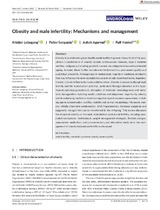| dc.description.abstract | Obesity is considered a global health problem affecting more than a third of the population. Complications of obesity include cardiovascular diseases, type 2 diabetes mellitus, malignancy (including prostatic cancer), neurodegeneration and accelerated ageing. In males, these further include erectile dysfunction, poor semen quality and subclinical prostatitis. Although poorly understood, important mediators of obesity that may influence the male reproductive system include hyperinsulinemia, hyperleptinemia, chronic inflammation and oxidative stress. Obesity is known to disrupt male fertility and the reproduction potential, particularly through alteration in the hypothalamic-pituitary-gonadal axis, disruption of testicular steroidogenesis and metabolic dysregulation, including insulin, cytokines and adipokines. Importantly, obesity and its underlying mediators result in a negative impact on semen parameters, including sperm concentration, motility, viability and normal morphology. Moreover, obesity inhibits chromatin condensation, DNA fragmentation, increases apoptosis and epigenetic changes that can be transferred to the offspring. | en_US |

